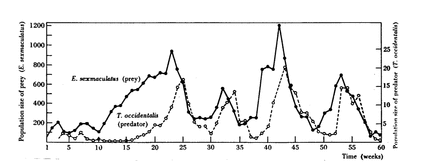The photo in the header above is just fantastic. It's from a company called Bugs for Bugs and is located in Mundubbera, Queensland, Australia. Check out their website: www.bugsforbugs.com.au. I chose this photo for the header because this tiny beetle larva is not what most people would consider a "top" predator, but it has a proven track record of consistent population regulation of a major pest of citrus trees throughout the world. Credentials enough to be ranked a top predator.
Top Predators
Top predators help maintain the overall health, balance and viability of all ecosystems.
Big, bold statement to be sure. But is it really as impacting as it should be...or needs to be? 
Would you believe me if I said that North American Gray Wolves were the key element to keeping groves of Aspen trees healthy in Yellowstone National Park? And you're like, "a top predator that eats meat keeps plants healthy? Ya right."
Its good to be incredulous. Its shows critical thinking skills. Or cynicism. Either way, check out some of the primary literature on the subject (and then go find some more): |
There are basically three types of natural enemies: Predators, parasitoids and pathogens. This page focuses on predators.
A spined soldier bug is killing a monarch larva. Some of you may look at this as a horrific, senseless act of wanton murder of a precious and vulnerable member of the environment. The appropriate biological reply to that should be, "well, not really."
Predators and population regulation
Probably one of the more difficult concepts to get in all of biological control, maybe even second to imperfect density dependent mortality. There are important biological distinctions between types of natural enemies (predators, parasitoids, pathogens) and each group functions to enact and maintain population regulation differently. But population regulation is a powerful phrase that can encompass the fortunes of literally millions upon millions of insect lives. And is the final call on whether a biological control program was successful or not. Population regulation basically means that a population of natural enemies that is purposefully released into a novel environment demonstrates the capability of reducing the targeted pest population numbers to acceptable levels. The predators kill off lots of prey, sure, but in a way that is effective, non-disruptive to other ecosystem functionalities, and benefits humans. It is in fact the "restore balance" that is the Holy Grail of biological control programs and the benefit that is largely ignored by biological control detractors. 
The graph above represents some of classic experiments by Carl Huffaker in the 50s and 60s showing the population ups and down of predators and their prey, in this case both are mites.
|
There is definitely one episode of a misguided use of a so-called predator to control pests that did not result in any population regulation and that is the cane toad in Queensland Australia. Here's a funny take on how the Aussie's have coped with the mess they created out of shear ignorance and arrogance. Biological control is not to be trifled with.
Here's the documentary that gives the full story.
This is not biological control gone wrong, it's just people being idiotic.
This is not biological control gone wrong, it's just people being idiotic.



